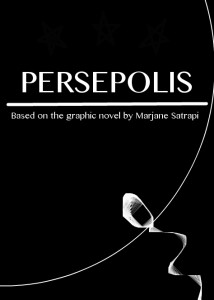Session Nine: “Persepolis”
December 8th, 2014 by leonpanAlthough I had originally written my response to Session Nine on “Jasmine and the Stars,” I wanted to do a creative project in response to “Persepolis” and highlight something really interesting that spoke out to me while reading it. Persepolis is an autobiographical account of Marjane Satrapi’s childhood in both pre- and post-revolutionary Iran, about the betrayal of the revolutionaries – some of which were dear family friends – when the overthrow of the Shah actually took place and the Islamic fundamentalists took over, and lastly, the terror that came about when the Iranian-Iraqi war took place. Satrapi’s narrative tells this entire story from the point of view of her adolescent self, and it was how the story was written from the perspective of one particular Iranian youth that really stuck out to me. Marji, as a child, is innocent, but profoundly passionate and sincere. She has trouble understanding why her mother wants the traitors massacred – “Why does my mother want people dead when she tells me to forgive?” – and she is quick to bullying her classmate when she finds out that he – and his father – have different beliefs than she was taught by her own parents. In a way, Marji, just like any other child with an open mind and a strong-willed heart, is incredibly vulnerable and also volatilely dangerous. Because her adolescent mind is quick to believe and easy to mold, and because she has yet to truly think for herself, she can almost be seen as the fertile soil in the field that can be used to plant and nurture any type of seed. Although it’s not seen very clearly because her points of view are clearly defined by what her parents have raised her with, it can’t be denied that a parent fostering a child with the same point of view is also a form of manipulative molding (as harsh as it sounds), albeit one that is socially accepted.
For my creative project, I decided to create a movie poster for Persepolis; rather than go for a similar design to that of the actual movie poster/book cover, which features Satrapi’s beautiful graphic-novel cartoons, I aimed for a more simplified, sleek, and modern feel, the result of which you see below. I created the poster using a photo-shop software known as GIMP (GNU Image Manipulation Program) – kind of a free Adobe Photoshop, if you will. It features the title of the movie, the novel and the author that it was based off of, and of course, the striking digital representation of the fertilization of an egg cell. This is a photo that we’ve all seen before, whether in biology class or elsewhere; although many may find it odd that I chose to use such a photo to represent this book (and the movie), I thought it was fitting because it was not only controversial and very striking to the eye, but also representative of the planting of seeds in young peoples’ minds. In the way that the joining of a sperm and egg cell in the process of fertilization forces genetic information to join together to result in and shape a vibrant, creative, and unique human being, the gradual influx of information (more specifically, biased information) in a child’s mind causes that child to create new thoughts, new beliefs, and new ideas. With these new ideas, he or she carries the ability to act upon his or her newfound ideals, and thus a new active citizen is formed – one that is capable of playing a dynamic role in society, even if that role stems from the same roles that his or her parents or role models played during youth.
